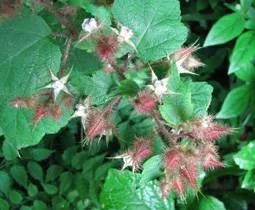
Wineberry (Rubus phoenicolasius) is an invasive shrub in the same genus as raspberries and blackberries. Wineberry creates spiny, inpenetrable thickets that reduce an area’s value for wildlife habitat and recreation. It was introduced to North America in the 1890s as breeding stock for raspberries. It was found invading natural areas by the 1970s, and it is currently recorded in most states east of the Mississippi River and in Alabama (USDA PLANTS Database). Wineberry replaces native vegetation, including native edible berry shrubs. It is differentiated from other berry-producing canes by the reddish appearance of its stems (caused by a dense coat of red hairs), silvery underleaf surfaces, and bright red berries. Management can be obtained through mechanical, chemical, or combination of control methods.
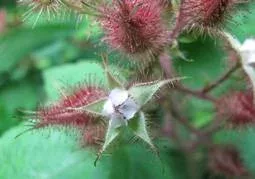


Wineberry is a close relative of other raspberries and blackberries. It grows in long shoots called canes up to six feet long, which can re-root at the tips when they touch the ground. Wineberry canes grow in two stages; in the first year they form a vegetative cane, and in the second year the cane becomes woody and produces lateral branches, flowers, and fruit (technically drupes, an aggregation of single seeded drupelets, but for clarity the term fruit will be used). Wineberries are perennial; while the canes each live two years, the plant produces new canes every year. Leaves are produced in April, flowers in May, and fruit from late June to August; leaves drop in late November. Wineberry does not need pollen from another individual to set seed, and therefore may reproduce more easily than natives like saw-toothed blackberry (Foss 2005).
Wineberry has a wide range of tolerance for light, soil type, and moisture level, and is hardy to USDA Zone 5 (annual minimum temperatures to -20F). While it is most productive in edge and wasteland habitats, it can be found in most habitats that exist in New York (Innes 2009), including forested habitats. Wineberry seeds are spread by animals, and seeds dropped on the forest floor can germinate when falling trees provide light to the forest floor. Once established, wineberry can persist indefinitely and reproduce once further disturbance occurs (Innis, 2005).
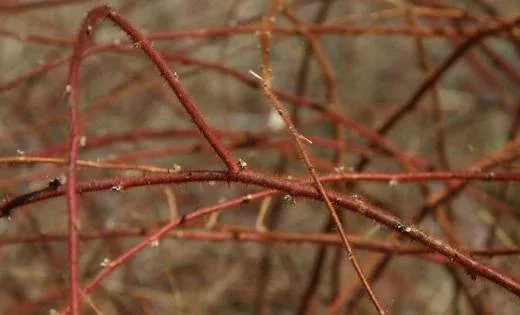

Wineberry is related to other raspberries and blackberries, and shares characteristics of both. Like raspberries, wineberry has silvery underleaves, a fruit core that remains on the stem when the ripe fruit is picked, and thorns. It is differentiated from other raspberry species by the fine red hairs that grow densely on its stems (and flowers) causing a reddish hue to the plant. Wineberry fruit is vibrantly red when ripe, which helps differentiate it from native black raspberries and blackberries; it also has three leaflets per leaf rather than five, which separates it from many blackberry species. Unique to wineberry is its small, greenish, hairy flowers with white petals and the way its fruit remain covered by sepals (greenish petal-like structures) until almost ripe.
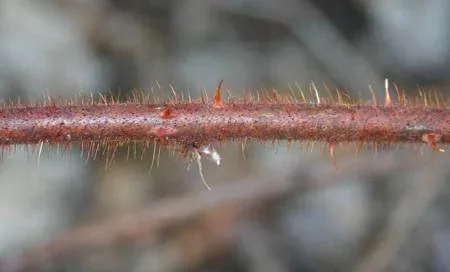

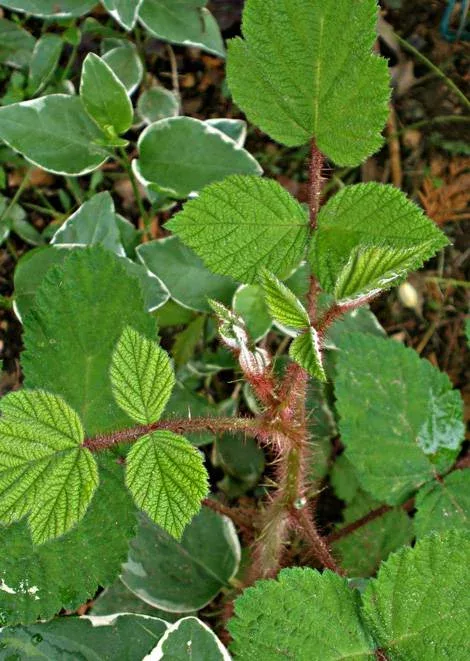
There is quite a range of native and introduced Rubus species in New York; the wikibook Flora of New York has an excellent, easy to navigate identification website which includes wineberry. The more common species easily confused with wineberry are shown below. For a more complete look at the Rubus genus, the Flora of Michigan has an excellent online key.
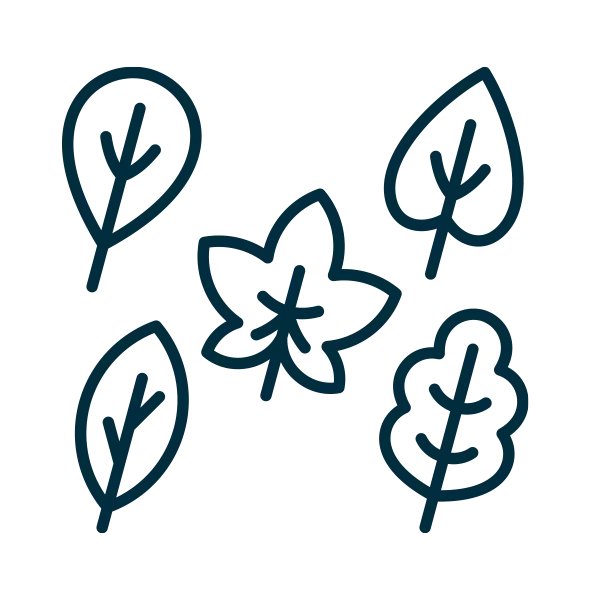
Rubus odoratus (purple-flowering raspberry or thimbleberry) has maple-shaped leaves that are soft and hairy; leaves not silvery; flowers pinkish-purple. Fruit is flatter and fuzzier than a raspberry, forming more of a cup shape.
Black raspberry (Rubus occidentalis) has whitish underleaves, but flowers hold their white petals out from the center of the flower, and fruit are usually purple-black (occasionally golden). Stems are green with a bluish cast that rubs off and have sparse, fairly robust thorns. Canes tip-root.
Red raspberries (Rubus idaeus, Rubus strigosus and many hybrids) have whitish underleaves and white petals, with red fruit, like wineberries. Stems are not covered in red hairs, are more lightly armed than black raspberry, and lack the bluish-white cast on their stems. Flowers might have a few hairs, but are not densely hairy like those of wineberry.
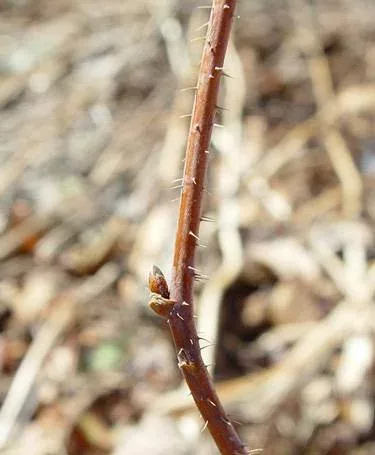
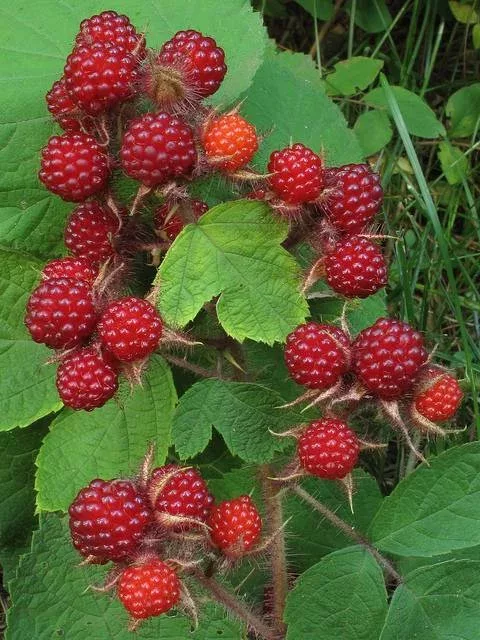
New York has several species of native blackberries, all of which have green rather than silvery underleaves and solid-cored fruit (mostly black when ripe). Some have five to seven leaflets. Identification to species can be difficult. While the skin on some species is reddish or purplish, none are covered in reddish hairs like wineberry, and many are heavily armored with thorns.
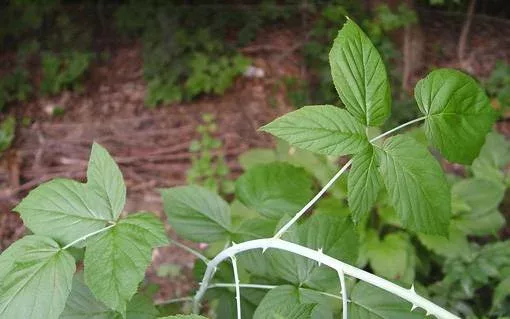
Evergreen blackberry (Rubus laciniatus) is an invasive blackberry. It has highly dissected leaves and black fruit with a solid core.
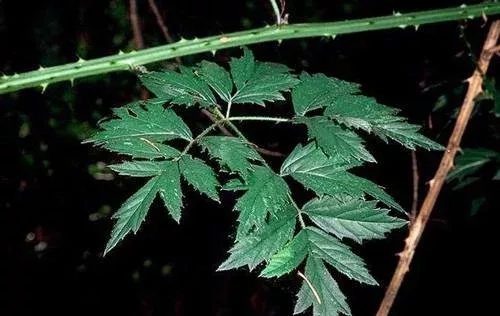
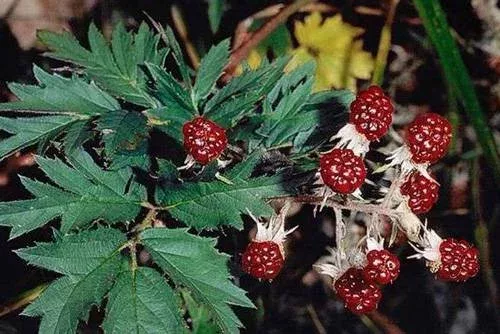
Himalayan blackberry (Rubus armeniacus) is also an invasive blackberry. It has stout, heavily armed but not hairy stems that grow up to 20 feet, tip roots like wineberry does, and produced large, sweet, dark-purple to black solid-cored fruit. It is the only blackberry with a whitish or grey-green underleaf, but usually has five leaflets instead of three, which along with its pinkish-white flowers and black fruit differentiate it from wineberry.
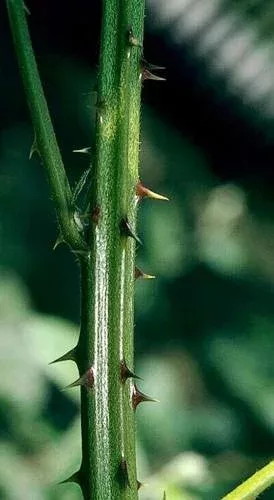

Wineberry can form dense, impenetrable thickets in natural areas, making the habitat unusable for some species and creating hiding places for others. It is more aggressive than many of the native raspberry and blackberry species, and has a wider range of tolerance for light, soil type, and moisture. Its establishment in forest understories as disturbance occurs can lead to its spread even in mature forests. There has been no study to date documenting its specific impact on native species.


Wineberry control is more straightforward than control of many other invasive plants in New York. While any root fragments may start a new plant, wineberry does not have a vigorous underground storage structure; this makes it easier to control than, for instance, Japanese knotweed or lesser celandine. It is also susceptible to common pesticides.
For any invasive species control project, it is important to have a plan for the location before control begins. Disturbance without replanting often results in the return of either the same invasive species or other invasives to the site; have a restoration plan in place before starting invasive species removal.
Mechanical control
Hand pulling wineberry or digging with a spading fork can be a successful strategy in small patches or where repeat visits are not costly, particularly if native species are planted where the ground has been disturbed. Return visits for a few years will be necessary to remove new plants that sprout from root fragments. As wineberry is armed with thorns and hairs, minimizing exposed skin during mechanical control is advisable.
Chemical control
Wineberry can be controlled using systemic herbicides such as glyphosate or triclopyr (Bargeron et. al., 2003). When using pesticides, be aware that many pesticides are prohibited within 100’ of water, as they are toxic to aquatic life and/or fail to break down in water. Some formulations of glyphosate-based herbicides are permitted for use near water, but the most common formulation (Roundup) is not permitted for use near water due to an adjuvant (chemical that helps the glyphosate stick to plant surfaces) that is toxic in aquatic habitats. Triclopyr also has both aquatic-permitted and prohibited formulations; choose carefully based on the characteristics of your treatment area. Always follow instructions on the label of any pesticide, and remember that New York has its own regulations for pesticides, both for the entire state and for specific regions like Long Island that have special environmental considerations. For New York State regulations, visit the DEC website: http://www.dec.ny.gov/regulations/8527.html.
Foliar application and cut-stump application are both recommended in various fact sheets (Massachusetts Audubon, Innes 2009, bugwoodwiki), but no experiments have been published on the relative efficacy of pesticides or application methods on wineberry (2015).
This map shows confirmed observations (green points) submitted to the NYS Invasive Species Database. Absence of data does not necessarily mean absence of the species at that site, but that it has not been reported there. For more information, please visit iMapInvasives.
David L. Gorchov, E. Thompson, J. O’Neill, D. Whigham and D.A. Noe. 2011. Treefall gaps required for establishment, but not survival, of invasive Rubus phoenicolasius in deciduous forest, Maryland, USA. Plant Species Biology (26) 221–234.
Innis, Anne Foss. 2005. Comparative ecology of the invasive Rubus phoenicolasius and the native Rubus argutus. Dissertation from University of Maryland, College Park MA.
Innes, Robin J. 2009. Rubus phoenicolasius. In: Fire Effects Information System, [Online]. U.S. Department of Agriculture, Forest Service, Rocky Mountain Research Station, Fire Sciences Laboratory (Producer).
Massachusetts Audubon Society’s website on wineberry. Accessed May 21, 2015 at http://www.massaudubon.org/learn/nature-wildlife/invasive-plants/wineberry .
Nonenmacher, Randy A. Wikibook. Flora of New York. Accessed May 21 2015 at http://en.wikibooks.org/wiki/Flora_of_New_York/Rosoideae_1#Genus_Rubus .
Spencer, Neal R. 2009. Plant Conservation Alliance’s Alien Plant Working Group: Wineberry fact sheet. Accessed May 21, 2015.
Swearingen, J., K. Reshetiloff, B. Slattery, and S. Zwicker. 2002. Plant Invaders of Mid-Atlantic Natural Areas. National Park Service and U.S. Fish & Wildlife Service, 82 pp. Accessed at: USDA PLANTS Database. Available at http://plants.usda.gov/core/profile?symbol=RUPH. Accessed June 16, 2015.
Weldy, Troy, David Werier, and Andrew Nelson. 2015 New York Flora Atlas. [S. M. Landry and K. N. Campbell (original application development), USF Water Institute. University of South Florida]. New York Flora Association, Albany, New York. Available online at http://newyork.plantatlas.usf.edu/Plant.aspx?id=2720 . Accessed May 21, 2015.
